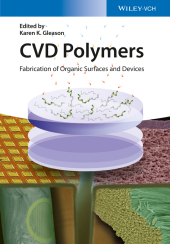 Neuerscheinungen 2015Stand: 2020-02-01 |
Schnellsuche
ISBN/Stichwort/Autor
|
Herderstraße 10
10625 Berlin
Tel.: 030 315 714 16
Fax 030 315 714 14
info@buchspektrum.de |

Karen K. Gleason
CVD Polymers
Fabrication of Organic Surfaces and Devices
Herausgegeben von Gleason, Karen K.
1. Auflage. 2015. XX, 462 S. 150 SW-Abb., 50 Farbabb. 244 mm
Verlag/Jahr: WILEY-VCH 2015
ISBN: 3-527-33799-7 (3527337997)
Neue ISBN: 978-3-527-33799-6 (9783527337996)
Preis und Lieferzeit: Bitte klicken
Overview of Chemical Vapor Deposited (CVD) Polymers
Part I. FUNDAMENTALS
Growth Mechanisms, Kinetics, and Molecular Weight
Conformal Coverage and Templated Structures
Initiation Strategies
Plasma Polymers
Molecular Layer Deposition (MLD)
Part II. MATERIALS CHEMISTRY
Functional, Responsive, and Grafted CVD Polymer SurfacesMultifunctional Reactive Polymer Coatings
CVD Fluoropolymers
CVD Conjugated Polymeric Conductors and Semiconductors
Part III. APPLICATIONS
Controlling Wetting with Vapor Deposited Polymers
Membrane Modification by CVD Polymers
Ubiquitous and Unusual Substrates
CVD Polymer Surfaces for Biotechnology and Biomedicine
Organic Device Fabrication and Integration with CVD Polymers
Part IV. REACTORS AND COMMERCIALIZATION
Commercial Research Tools and Large-Area CVD Polymers
Polymer Vapor Deposition (PVD) Reactors and Commercialization
CVD Polymers for the Semiconductor Industry
The method of CVD (chemical vapor deposition) is a versatile technique to fabricate high-quality thin films and structured surfaces in the nanometer regime from the vapor phase. Already widely used for the deposition of inorganic materials in the semiconductor industry, CVD has become the method of choice in many applications to process polymers as well. This highly scalable technique allows for synthesizing high-purity, defect-free films and for systematically tuning their chemical, mechanical and physical properties. In addition, vapor phase processing is critical for the deposition of insoluble materials including fluoropolymers, electrically conductive polymers, and highly crosslinked organic networks. Furthermore, CVD enables the coating of substrates which would otherwise dissolve or swell upon exposure to solvents.
The scope of the book encompasses CVD polymerization processes which directly translate the chemical mechanisms of traditional polymer synthesis and organic synthesis in homogeneous liquids into heterogeneous processes for the modification of solid surfaces. The book is structured into four parts, complemented by an introductory overview of the diverse process strategies for CVD of polymeric materials. The first part on the fundamentals of CVD polymers is followed by a detailed coverage of the materials chemistry of CVD polymers, including the main synthesis mechanisms and the resultant classes of materials. The third part focuses on the applications of these materials such as membrane modification and device fabrication. The final part discusses the potential for scale-up and commercialization of CVD polymers.
Karen K. Gleason is Associate Provost and the Alexander and I. Michael Kasser Professor of Chemical Engineering at MIT, USA. Her BSc and MSc degrees are from MIT and her PhD is from the University of California at Berkeley. Karen K. Gleason has authored more than 300 publications and holds 18 issued US patents for CVD polymers and their applications in optoelectronics, sensing, microfluidics, energy storage, and biomedical devices, and also for the surface modification of membranes. At MIT, she has served as Executive Officer of the Chemical Engineering Department; Associate Director for the Institute of Soldier Nanotechnologies; and as Associate Dean of Engineering for Research. She is a Member of the National Academy of Engineering, a Fellow of the American Institute of Chemical Engineering (AIChE) and has held the Donders Visiting Chair Professorship at Utrecht University in 2006. Her awards include the ID TechEx Printed Electronics Europe Best Technical Development Materials Award, the AIChE Process Development Research Award, and Young Investigator Awards from both the National Science Foundation and the Office of Naval Research.


